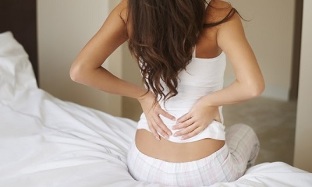
Low back pain is a symptom that can be associated with various medical conditions. They can be permanent or periodic, local or generalized.
If a person has pain in the lumbar spine, he is prescribed a comprehensive examination to determine the cause.
Possible causes of low back pain and their characteristics
Low back pain can be caused by a variety of reasons, depending on the severity of the discomfort. Pain syndrome reduces a person's quality of life, restricts mobility and makes it impossible to perform daily tasks.
There are many causes of lumbar back pain. Some of them are quite serious and require immediate specialist intervention.
Lumbar sciatica
Lumbar sciatica is a disease of the musculoskeletal system in which there is compression and inflammation of the spinal roots. This pathology has a secondary character, as it develops against the background of degenerative processes of the musculoskeletal system.
The most common symptoms in this case are:
- Pain syndrome, aggravated by sudden movements, weight lifting. The location of the pain depends on the degree of damage. The syndrome can affect the lumbar and gluteal region, the back or the front of the thigh. If there is damage to the nerve endings that are located below the first and second lumbar discs, then the patient has lumbago in the lumbar region and buttocks.
- Increased severity of pain when coughing, sneezing.
- Inability to stay in one position for a long time.
- Mobility disorders: inability to tilt the trunk forward, backward or sideways, inability to bend the toes of the lower limbs.
In radiculitis of the lumbar spine, the pain usually appears suddenly and stops spontaneously. The next time the pain becomes more acute, pronounced.
Osteoporosis
Osteoporosis of the spine is a phenomenon in which the process of extracting calcium from the bones takes place and the activity of the cells responsible for bone growth is disrupted. Under such conditions, the bones are quickly destroyed and their density is constantly decreasing. It is difficult to suspect osteoporosis in the early stages of development.
Most often the patient feels sharp pain in the lumbar spine at a time of intense tension - a sharp turn of the body, falling, lifting weights.
In addition to severe lower back pain, osteoporosis has symptoms such as:
- chronic fatigue;
- bloating;
- impaired mobility of the spine.
In a compression fracture provoked by osteoporosis of the lumbar spine, there is acute pain, which increases on palpation of the affected area, as well as muscle spasm.
Scoliosis
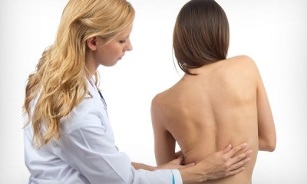
In scoliosis of the lumbar spine, its structures deviate to the right or left. These changes affect the condition of the surrounding tissues: they are irritated, in the musculoskeletal structures appear foci of inflammation.
Left scoliosis is most commonly diagnosed. In left-handers, scoliosis develops on the right side.
In the initial stage, scoliosis of the lumbar spine may not appear in any way. Negative changes can be traced only by the results of X-ray examination.
The typical symptoms in this case, in addition to the severe pain in the lumbar spine, are:
- sloppy;
- swelling in the lumbar region;
- chest pain;
- displacement of the pelvic girdle, due to which one lower limb becomes shorter than the other;
- blade divergence.
Characteristic features of the pain in scoliosis of the lumbar spine: its appearance at the beginning of physical activity, reducing the intensity of discomfort when walking. The pain is usually short-lived.
Injury
Waist injuries occur during falls, bumps. The lumbar region is most susceptible to trauma.
Lumbar spine injuries are closed tissue and part of the spine that do not cause anatomical abnormalities. This type of injury is common in athletes as well as in people working in the workplace.
The following additional symptoms are observed in bruising:
- hematoma formation;
- redness of the skin;
- increased pain when pressing on the injury site.
If the injury is severe, the conduction of nerve impulses in certain areas of the lumbar spine may be impaired, in some cases - a complete loss of sensitivity.
Symptoms are more pronounced in lumbar injuries and include the following:
- pain when probing the affected area;
- growing hematoma;
- pain when turning the body, inability to bend;
- swelling in the ankle area, indicating poor circulation;
- paralysis and paresis of the lower extremities.
Rheumatoid arthritis
Rheumatoid arthritis of the spine is another possible cause of low back pain. In this case, the joints located in this area are affected.
Rheumatoid arthritis pain most often occurs at night, usually in the morning. In the initial stage, the syndrome can be suppressed with the help of special exercises, but at night the pain reappears.
Other symptoms: increased local temperature above the affected area, accumulation of fluid in the cavities of the affected joint.
Osteochondrosis
Osteochondrosis is a pathological process in which the intervertebral discs lose their elasticity. As the disease progresses, cracks and hernias form in them.
In the initial stage of osteochondrosis, low back pain is rare and does not differ in intensity. In the future, they become markedly chronic. The patient feels stiffness on the move, constant fatigue. Difficulty in bending and lengthening the back.
Pain often radiates to the lower extremities. At the same time there is a tingling, tingling sensation.
Increase in the intensity of unpleasant sensations occurs with increasing physical activity, performing sudden movements, lifting weights.
Malignant tumors
If your back hurts in the lumbar region, it may be related to such a dangerous pathology as cancer. In this case, the malignant tumor does not necessarily affect the bone structures of the spine. In this case, the pancreas behind the stomach may be affected so that the pain can be attributed to the lower back. Severe pain indicates advanced stages of cancer.
Also, lumbar pain may be related to the fact that tumors of other organs have metastasized to that area.
In women, low back spasm may be a sign of ovarian cancer. In men, acute and prolonged spasms signal a prostate tumor.
Gynecological diseases
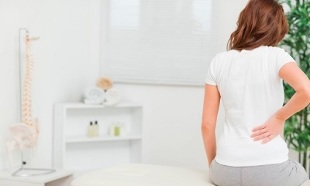
Women are often concerned about lower back pain. A similar symptom can occur under the influence of pathologies such as:
- rupture of ovarian tissue;
- pathological processes of the uterus;
- cysts in the ovaries;
- cervical cancer;
- inflammatory processes of the fallopian tubes;
- benign formations on the inner wall of the uterus.
Low back pain often occurs in women who have had an abortion. The unpleasant sensations are caused by mechanical damage to the tissues of the uterus and the prolonged process of wound healing.
In women with gynecological diseases, lower back pain, pulling, pain. In addition, there is a violation of the menstrual cycle, loss of strength, irritability, fever. Often the pain syndrome is complemented by secretions of different consistency and color from the vagina.
The pain syndrome in this case is caused by hormonal imbalances and inflammatory processes that spread to the tissues of the lumbar region.
Kidney disease
Low back pain is a sure sign of kidney disease.
A similar symptom accompanies pathologies such as:
- urolithiasis;
- pyelonephritis;
- glomerulonephritis;
- nephroptosis (kidney prolapse).
In the presence of urinary stones, the pain in the lumbar region is not very pronounced, it is dull in nature. In inflammatory processes that involve the kidneys, the pain is painful and constant. Its location in this case is to the left and right of the spine.
Acute pain is indicative of renal colic. The pain radiates to the groin, inner thigh, anterior abdominal wall.
Additional manifestations that may indicate kidney disease include:
- high blood pressure;
- swelling of the arms, legs, face, which appears after waking up and disappears during the day;
- change in urination: the process can be rapid and painful or, conversely, infrequent, to a complete stop;
- lethargy;
- increased sweating;
- impaired appetite.
Discomfort and pain in the lower back are often associated with the fact that the fetus compresses the kidneys in pregnant women. In this case, the pain syndrome is not associated with any pathology, it is a completely natural phenomenon.
Diseases of the genitourinary system in men
In the stronger sex, low back pain often occurs in diseases of the genitourinary system. Most often the discomfort is caused by prostatitis - an inflammatory process of the prostate gland. In this disease, the process of urination and sexual function is impaired. In addition to pain in the lower back, there is also pain in the lower abdomen.
Another male disease that contributes to lumbar pain is epididymitis, inflammation of the epididymis.
Lumbar myositis
Lumbar myositis is an inflammatory process of muscle tissue, which manifests itself in pain and weakness in the muscles, sometimes in their atrophy. The disease can be caused by infectious processes, trauma, hypothermia, metabolic disorders in the body.
This pathology is characterized by:
- lower back pain that worsens with movement;
- feeling of dull muscle weakness;
- swelling, redness of the skin.
Bone tuberculosis
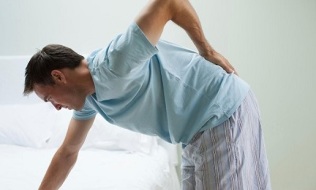
In tuberculosis of the spine, the lower back often hurts. The nature of the pain syndrome in this case depends on how many vertebrae are involved in the pathological process, as well as the degree of deformation of the structures.
The main signs of spinal tuberculosis are:
- Severe pain in the lumbar region. This localization is related to the fact that the lumbar region is the largest part of the spine that receives maximum loads.
- Increased night sweats.
- Increased lymph node size.
- Rise in temperature within 37, 1-37, 3 degrees.
- Constant fatigue.
With the progression of tuberculosis of the spine there is an angular curvature of this structure, the development of abscesses in the lumbar and thoracic region.
Climax
Fading of sexual function in women is often accompanied by lower back pain. A similar phenomenon is associated with a decrease in ovarian activity, which is reflected in the level of the hormone estrogen. Under conditions of its deficiency, bone tissue becomes more fragile and prone to damage.
Against the background of hormonal changes, the musculoskeletal system as a whole becomes vulnerable: the intervertebral cartilage and discs become weaker, muscles and ligaments lose elasticity. As a result, the lumbar region, which is always the most stressed, is at particular risk.
In addition to pulling pain in the lower back, postmenopausal women suffer from headaches, excessive sweating, hot flashes.
Vascular pathology
Circulatory disorders provoked by pathological vascular processes can also cause lumbar pain. Thrombophlebitis, atherosclerosis, phlebothrombosis contribute to the onset of pain syndrome.
The appearance of blood clots in the veins, inflammation of the vascular walls, narrowing of the vascular lumen - all this impedes the full flow of blood and thus limits the supply of oxygen to tissues and structures of the body, which adversely affects their condition.
Additional symptoms accompanying vascular disease are swelling of the veins, heaviness in the limbs and bluish skin color.
Intestinal diseases
In intestinal diseases, the pain may radiate to the lower back. This is due to the fact that the intestinal tract occupies a significant place in the abdominal cavity. If any part of it undergoes pathological changes, then it grows, putting pressure on other organs. The spine is also at risk.
The pain spreads to the lumbar region in ulcerative colitis, exacerbation of appendicitis, intestinal obstruction, irritable bowel syndrome.
In case of spread of pathological processes in the stomach, the pain is localized in the upper back. They appear after eating, with the appearance of a feeling of hunger, in case of abuse of harmful products.
The following symptoms occur in parallel:
- flatulence;
- stool disorders;
- abdominal pain.
Obesity
Being overweight puts extra stress on the spine, especially the lumbar spine. Constant pressure creates a risk of developing pathologies of the musculoskeletal system, provokes injuries of the intervertebral discs, curvature of the spine and the development of osteochondrosis.
In addition to the above pathological causes, lumbar pain can occur due to prolonged driving or computer use, excessive workload in the gym, hobbies for working in the summer cottage and sedentary lifestyle.
Which doctor should I go to?
Lower back pain is often caused by serious disorders in the body, so it is important to consult a doctor in a timely manner to diagnose the true cause and treat it.
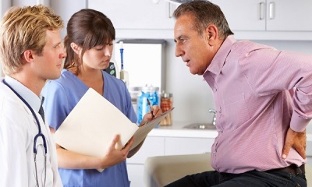
Consultation with a specialist is required if the patient has lumbar pain:
- is regular;
- appears constantly after physical exertion;
- does not disappear when you lie down;
- is accompanied by tingling in the extremities and fever.
The main specialists you should contact if your back hurts in the lumbar region are:
- vertebrologist (treats osteochondrosis and other neurological diseases);
- neurologist;
- nephrologist (urologist): this specialist diagnoses and treats if low back pain is associated with pathological processes in the genitourinary system.
If necessary, other specialists are involved in the process of diagnosis and treatment: orthopedist, surgeon, gynecologist, oncologist, gastroenterologist.
Diagnostics
The following diagnostic measures are prescribed for lumbar pain:
- general examination, identification of the anamnesis;
- testing to determine restrained nerve endings;
- blood test to assess hemoglobin level;
- myelography;
- X-ray examination of the spine;
- NMR;
- CT;
- ultrasound of abdominal organs;
- endoscopy of the uterus, stomach, intestines;
- bone scintigraphy.
The listed activities allow to compile a complete picture of the patient's condition, to identify the disease that causes pain in the lumbar spine, as well as to determine an adequate course of treatment.
Approaches to treating low back pain
The main course of treatment for low back pain depends on what caused the symptom. Therapy is aimed at eliminating the existing disease.
General principles
Treatment is based on the following:
- the use of drugs to suppress inflammatory processes;
- conducting physiotherapeutic procedures aimed at accelerating the recovery of the affected structures;
- physiotherapy exercises.
In the process of treatment the patient should avoid active sports activities, as well as any physical activity, so as not to aggravate the course of the pathological process. During the rehabilitation period, the patient may be advised to practice yoga, swimming and hiking.
Therapy also includes dietary adjustments. The patient must refuse heavy food, all greasy and fried. It is important to give up bad habits - this will significantly speed up the healing process.
Medicines

For lumbar pain, medications are usually prescribed in the form of injections that include vitamin B. The tasks of these medications are:
- accelerating the recovery of damaged nerve fibers;
- increase in the functional activity of the central and peripheral nervous system;
- acceleration of metabolic processes.
In case of severe, intense pain in the lower back, powerful painkillers are prescribed.
Non-steroidal anti-inflammatory drugs that control inflammation are also given by injection.
After a course of injections of non-steroidal anti-inflammatory drugs, drugs from this group are prescribed in the form of tablets for oral administration.
Drugs such as muscle relaxants are prescribed for muscle spasm that provokes low back pain.
Patients are also prescribed external medications. They usually have a warming effect and help to suppress pain. They are prescribed only as part of a comprehensive treatment.
Special ointments are recommended for lumbar pain.
Therapeutic gymnastics
A set of therapeutic exercises is prescribed only after reducing the pain syndrome. In the period of exacerbation therapeutic exercises are contraindicated.
For lumbar pain, the following exercises are recommended:
- Raises the pelvic area.You should lie on your back and bend your legs at a right angle. The pelvis should be carefully raised and returned to its original position. Repeat 10-15 times.
- Maintain balance.The exercise is performed in an upright position. You should stand on tiptoe and try to maintain balance in this position for about 10-15 seconds. Repeat 3-5 times.
- Lift your legs from a lying position.Lie on your back, lifting your straight lower limbs as high as possible. Perform 5-10 lifts for each leg.
- Movement on the seat.You have to sit on the floor, straighten your back. Using the pelvis and buttocks, move forward, then backward. You have to walk this way about 2 m forward and as much back. The number of approaches is 2-3.
You should not do gymnastics in case of spinal injuries, tumors and hernias, as well as in the presence of acute diseases.
Physiotherapy
Physiotherapy procedures are performed provided that the pain in the lower back is not caused by an acute inflammatory process. The acute pain syndrome is first relieved by conservative methods and only then is physiotherapy prescribed.
For lumbar pain, the following procedures are prescribed:
- Magnetotherapy.This method improves blood circulation in the affected area.
- Electrophoresis.This method is necessary if you want to speed up the delivery of drugs to the lesion (analgesics, nonsteroidal anti-inflammatory drugs, chondroprotectors).
- Laser therapy.The technique allows you to normalize metabolism and improve blood circulation in the affected areas.
Nutrition
To strengthen bone elements, you need to include in the diet cottage cheese, dairy products and actually whole milk, fatty sea fish, black bread.
If the patient is overweight, which creates additional strain on the spine, it is necessary to exclude flour, sweet and sweet carbonated beverages from the diet.
Folk remedies
Traditional methods of treatment should in no way become the basis for the treatment of low back pain. They are used exclusively as an adjuvant method and are used only with the approval of the attending physician.
For lower back pain you can use the following recipes from traditional medicine:
- Ointment based on honey.To prepare a healing composition, you need to take 3 tablespoons of natural honey and melt it with a water bath. Cool the composition. Add 2 tablespoons of pharmacy alcohol to honey, add 100 g of Vaseline and rub into areas where the pain is localized. For greater effectiveness you can apply a compress with this ointment. In this case, it is not rubbed into the skin, but spread on it in a thin layer and placed on a transparent foil and wrapped on top with a warm scarf. Leave the compress for 3-4 hours, then wash the composition with warm water.
- Salt compress.It is necessary to dissolve the table salt in hot water (proportions - 1: 10), stir. Moisten a gauze cloth folded in several layers in the prepared solution, cover the lower back with a compress, wrap it with a towel and warm it with a scarf. Leave on overnight, remove the rest of the compress in the morning.
- Garlic compress.You need to take 3 heads of garlic, peel, chop. The resulting mass is poured with warm water (2 cups), leave for 3 hours. Moisten a cotton cloth in the infusion and sprinkle it with freshly squeezed lemon juice over the entire surface. Apply a cold compress. Leave for 20 minutes on a damp cloth to reach body temperature. Then repeat the procedure to apply the compress. This can be repeated until the patient feels relief.
- Compress with body.You need to mix bodyagi powder with olive oil in a ratio of 1: 30. Lubricate the lower back pain with the resulting composition, leaving the product on the skin for 40 minutes. After the specified period, the product must be washed with warm water.
- Compress of dried burdock leaves.You need to moisten the raw material in boiling water, apply it to the back, wrap it with a warm scarf on top. Leave the compress on for at least an hour.
- Baths with additives.Taking a bath can reduce the severity of the pain. As additives can act 200 g of mustard powder, 600 ml of broth on mint leaves. Take a bath within 20 minutes. The water should be warm.

All the listed treatments are designed to relieve low back pain, ie they are symptomatic.
The treatment of a specific diagnosed disease should be performed according to a separate scheme.
Prevention
To reduce the risk of lower back pain, you should:
- watch your posture;
- stand and walk with only your back straight;
- perform special exercises to strengthen the spine and back muscles;
- do not expose the spine to excessive loads, moderately perform exercises that use the muscles of the back;
- avoid hypothermia;
- , as far as possible, do sports that do not negatively affect the spine: swimming, yoga, walking are especially useful;
- do not make sudden movements when lifting loads;
- sleeps on a mattress with medium hardness, best - orthopedic, the pillow should also be orthopedic and medium size;
- monitor your weight, if necessary, follow a diet and participate in special exercises to combat excess weight;
- Take vitamin and mineral complexes, especially during hormonal changes in the body.
Lower back pain can be associated not only with diseases of the spine, but also with dysfunction of internal organs. During diagnostic measures, a specialist can determine the true cause of the pain syndrome. Both the symptom itself and its cause must be treated.

























